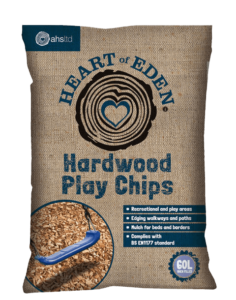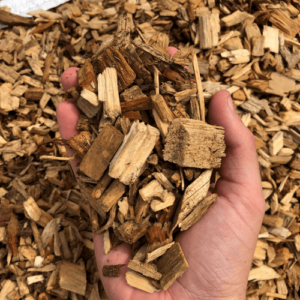Are hardwood play chips suitable for school gardens?
Jan 8th 2024
Imagine transforming your school garden or playground into a vibrant and educational space for children to explore and learn. But with so many options available, you may be wondering, are hardwood play chips the right choice? In this article, we will explore the suitability of hardwood play chips for school gardens and playgrounds, highlighting their benefits and considerations to help you make an informed decision for your outdoor space.
Introduction
School gardens have become increasingly popular in education, offering students a hands-on learning experience and fostering a deeper connection with the natural world. These outdoor spaces provide opportunities for children to learn about plants, animals, and the environment while also promoting physical activity and mental well-being. In order to create a safe and inviting environment, the choice of materials used in school gardens is crucial. One such material that has gained attention is hardwood play chips, which offer a range of benefits for both aesthetic appeal and functionality.
Background on School Gardens
School gardens have a long history, dating back to ancient civilizations where gardens were used as outdoor classrooms. Today, they have evolved into dynamic spaces that enhance curriculum-based learning and provide students with firsthand experiences of plant growth and cultivation. These gardens serve multiple purposes, such as teaching children about agriculture, healthy food choices, and the importance of sustainability. Moreover, school gardens have been found to have a positive impact on students’ academic performance, as well as their physical and mental health.
Importance of Suitable Materials in School Gardens
The choice of materials in school gardens is key to ensuring the success and safety of these outdoor spaces. Suitable materials not only enhance the visual appeal of the garden but also contribute to its functionality and longevity. Elements such as pathways, seating areas, and play zones need to be carefully considered when selecting materials. In particular, the ground covering plays a significant role in providing a safe and accessible environment for children to learn and play. This is where hardwood play chips come into the picture.
Overview of Hardwood Play Chips
Hardwood play chips, also known as playground wood chips or playground mulch, are a popular choice for school gardens and playgrounds. Made from chipped hardwood trees, these chips offer a range of benefits that make them ideal for creating a safe and visually pleasing outdoor environment.
Benefits of Hardwood Play Chips

Natural Appearance and Aesthetics
One of the key advantages of hardwood play chips is their natural and aesthetically pleasing appearance. The earthy tones and texture of the chips blend seamlessly with the surrounding environment, creating a harmonious and inviting space for students to explore. Unlike high-maintenance materials such as concrete or asphalt, hardwood play chips provide a more organic and visually appealing landscape.
Durable and Long-Lasting
Durability is an essential factor to consider when choosing materials for school gardens, as these spaces are subject to heavy use and regular foot traffic. Hardwood play chips are known for their longevity and ability to withstand constant use. Unlike materials that can easily become damaged or worn out over time, hardwood play chips retain their shape and integrity even after extended periods of play and exposure to the elements.
Non-Toxic and Safe for Children
The safety of children is of paramount importance in school gardens and playgrounds. Hardwood play chips are free from toxins, chemicals, and impurities that could potentially harm children. They are specifically designed to meet safety standards, providing a cushioned surface that reduces the risk of injuries from falls. Furthermore, hardwood play chips do not retain heat like some other materials, making them more comfortable for children to walk and play on during hot weather.
Excellent Drainage Capabilities
Proper drainage is crucial in maintaining a healthy garden environment, especially during heavy rainfall or watering. Hardwood play chips have excellent drainage capabilities, allowing water to quickly permeate through the material and into the soil below. This prevents the accumulation of standing water, which could contribute to the growth of mold, mildew, or even the drowning of plants. By facilitating effective drainage, hardwood play chips help to maintain a healthy and thriving garden.
Considerations for School Gardens
While hardwood play chips offer numerous benefits, there are several important considerations that need to be taken into account when choosing them as the ground cover for school gardens.
Maintenance Requirements
Like all garden materials, hardwood play chips require regular maintenance to preserve their appearance and functionality. This includes raking and turning the chips to prevent compaction, as well as periodically replenishing them to maintain an adequate depth. It is important to consider the time and effort required for this maintenance when selecting materials for school gardens.
Compatibility with Other Garden Elements
The compatibility of hardwood play chips with other garden elements, such as raised beds, paths, and seating areas, should also be considered. The chips need to integrate seamlessly with these features to ensure a cohesive and accessible garden design. Additionally, consideration should be given to the ease of installation and flexibility in shaping the play areas to accommodate various garden layouts.
Potential Impacts on Plant Growth
While hardwood play chips offer many advantages, they can pose potential challenges to plant growth if not used properly. The chips can absorb moisture from the soil, which may impact the water retention capacity of the garden. Additionally, the decomposition of the chips over time can affect nutrient availability and soil pH. It is important to monitor the soil conditions and make any necessary adjustments to ensure optimal plant growth in school gardens.
Best Practices for Using Hardwood Play Chips

To ensure the effective and safe use of hardwood play chips in school gardens, several best practices should be followed:
Appropriate Depth and Thickness
Maintaining an adequate depth of hardwood play chips is essential for optimal performance. The recommended depth is typically around 6 inches to provide sufficient cushioning and impact absorption. However, it is important to consult safety standards and local regulations to determine the appropriate depth for specific age groups and play areas.
Proper Installation Techniques
The installation of hardwood play chips should follow proper techniques to ensure stability and longevity. This includes preparing the ground with adequate drainage, installing a suitable barrier to prevent weeds and grass from growing through, and spreading the chips evenly to achieve a consistent coverage. Following manufacturer guidelines and seeking professional advice can help ensure proper installation.
Regular Inspection and Maintenance
Regular inspection and maintenance are critical in preserving the effectiveness and safety of hardwood play chips. This includes checking for signs of compaction, splintering, or displacement, as well as removing any debris or foreign objects. Periodic replenishment of the chips should also be carried out to maintain the recommended depth and cushioning properties.






